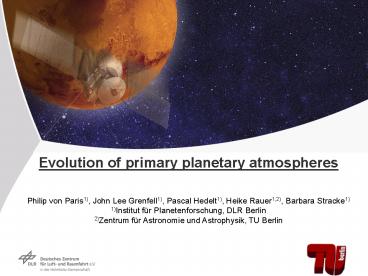Weltraum - PowerPoint PPT Presentation
1 / 16
Title:
Weltraum
Description:
Late Archaean: values of 3-4 mb. compatible. Tsurf= 273 K, from Kasting (1987) ... (3-4 mbar) for the late Archaean and early Proterozoic is compatible with ... – PowerPoint PPT presentation
Number of Views:274
Avg rating:3.0/5.0
Title: Weltraum
1
Evolution of primary planetary
atmospheres Philip von Paris1), John Lee
Grenfell1), Pascal Hedelt1), Heike Rauer1,2),
Barbara Stracke1) 1)Institut für
Planetenforschung, DLR Berlin 2)Zentrum für
Astronomie und Astrophysik, TU Berlin
2
Characterization of Terrestrial Exoplanets
- Satellite missions are on-going or planned to
look for small, rocky planets and characterize
their atmospheres CoRoT, Kepler, Darwin/TPF - Spectral signatures might be indicative of a
biosphere on a terrestrial planet - Atmospheric modeling helps in mission design and
data interpretation - Terrestrial planets are expected to be found at
different ages Models needed to track the
atmosphere in the course of planetary evolution
CNES
ESA
3
The faint young Sun paradoxon
The young Sun was less bright than today.
- - Surface temperatures below 273 K before 2
Gyr ago if greenhouse effect was at
present level (i.e., ?T 30 K) - But
- - Geological hints for liquid water as early
as 4 Gyr ago (e.g., Mojzsis et al. 1996,
Rosing Frei 2004)
r
Dashed line Gough (1981)
Plain line Caldeira and Kasting (1992)
4
Proposed solutions to the paradoxon
Atmospheric composition changed since the first
primitive atmosphere, hence the greenhouse
effect was more pronounced. Several greenhouse
gases have been proposed
Gas Reference Source
Ammonia Sagan Mullen 1972, Sagan Chyba 1997 Biology, photochemistry
Carbon dioxide Kasting et al. 1984, Kasting 1987 Outgassing
Methane Pavlov et al. 2000 Outgassing, methanogenes
Ethane Haqq-Misra et al. 2007 Photochemistry
5
Problems with the proposed solutions
- Ammonia Rapid photolytic destruction, UV
shielding via haze formation in an anoxic
atmosphere model results not clear ( Sagan
Chyba 1997 lt-gt Pavlov et al. 2001) - Carbon dioxide Sediment data sets upper limits
on partial pressure, much less than needed in
model studies (Rye et al. 1995, Hessler et al.
2004) - Methane Outgassing rates and biogenic
production not well determined (Pavlov et al.
2003 lt-gt Kharecha et al. 2005), dominating
photochemical sink not well established - Ethane Formation of needed hydrocarbon haze
dependent on ratio between methane and carbon
dioxide
6
This work Model description
Type 1D radiative-convective model for
temperature and water profiles Based on Kasting
(1984,1988), Pavlov et al. (2000) and Segura et
al. (2003) Temperature profile from radiative
equilibrium and convective adjustment Water
profile from relative humidity distribution
(Manabe Wetherald 1967)
7
IR-Fluss
stellarer Fluss
Klima
Chemie
Chemisches Reaktions-netzwerk berücksichtigt 55
Spezies, 220 Reaktionen
Stratosphäre Strahlungsgleichgewicht, F aus
Strahlungstransportgl.
Troposphäre trocken- oder feuchtadiabatisches
T-Profil
biogene-Flüsse
Profile chemischer Konzentrationen
T, p Profil
8
This work Model description
- New in our model
- Adapted IR radiation transfer modeling (MRAC) to
better simulate arbitrary terrestrial
atmospheres(based on RRTM model, Mlawer et al.
(1997)) - New spectral (added 1-3µm), temperature
(include Tlt150 K) and pressure (up to 10 bar)
coverage included - CO2 continuum absorption as opacity source in
IR - k-distributions recalculated for CO2-enhanced
background atmosphere with 5 CO2 and 95 N2
to include line broadening by carbon dioxide
9
Absorption coefficient k(v)
Net Flux
Density function
Distribution function
Net Flux
10
Validation of modified radiation scheme
Validation of k-distributions for normal air
background, i.e. modern Earth Example CO2
fundamental band at 15µm
RRTM (Mlawer et al. 1997) MRAC (This work)
11
Validation of modified radiation scheme
Validation of temperature profiles calculated
with RRTM and MRAC Example present Earth, 1bar
atmosphere, 78 nitrogen, 21 oxygen, 1 argon,
355ppm CO2, other gases (ozone,
methane and nitrous oxide) removed
Mid-stratosphere to upper mesosphereslight
disagreement due to extrapolation errors for RRTM
(yielding negative optical depths)
RRTM (Mlawer et al. 1997) MRAC (This work)
Surface up to mid-stratosphere excellent
agreement
Convective regime
12
Importance of T-grid for absorption coefficients
For shown validation run Calculated temperatures
outside RRTMtemperature grid ? extrapolation is
performed ? This yields negative absorption
cross sections, in contrast to
interpolation in MRAC
Tabulated values
RRTM
MRAC
Calculated values
True values
13
This work Model runs
- Vary Earth age
- Solar constants of 0.70 ,0.75, 0.80, 0.85, 0.90,
0.95 (equivalent to times 4.6 0.1 Gyr ago) - Constant nitrogen background pressure of 0.77 bar
- Add carbon dioxide until desired surface
temperature Tsurf isreached
Runs Tsurf/K
1-6 273
7-12 288
14
Results Atmospheric structure
Temperature inversion
Cold trap
Convective regime
- The structure of early Earth atmospheres differs
from the present one - The tropopause moves closer to the surface
- Cold trap no longer associated with a temperature
inversion - Tropopause, cold trap and temperature inversion
no longer at samealtitudes
15
Results Keeping the surface warm
Tsurf 288 K
Tsurf 273 K, from Kasting (1987)
Tsurf 273 K
Minimal CO2 concentrations for 273 K (lower plain
line) and 288 K (upper plain line), for
comparison values from Kasting (1987) for 273 K
(dashed line)
16
Conclusions
- Much less CO2 needed to keep surface of early
Earth above 273K - Calculated amount of CO2 (3-4 mbar) for the late
Archaean and early Proterozoic is compatible with
palaesol records, contrary to previous studies - Atmospheric structure very different from todays
structure - Outlook Model different evolutionary stages in
the future



























